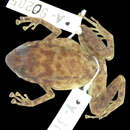Description
(
الإنجليزية
)
المقدمة من AmphibiaWeb articles
Cophixalus saxatilis reaches a large size, at least measuring 32 mm SVL and with relatively long hind limbs (TL/SVL, 0.46). Head is moderately wide with a flat and slightly oblique loreal region with a rounded canthus rostralis. The nostrils are closer to the tip of the snout than to the orbits. Eye to naris distance is equal to the internarial distance (E-N/IN, 1). The tympanum is distinct but not prominent; the diameter is half that of the eye. No teeth or vomerine elevations. The sternum is cartilaginous with the clavicles, procoracoids, and omosternum lacking. Fingers are unwebbed with relative lengths being 3>4=2>1. First finger is half the length of the second with a terminal disc barely broader than the penultimate phalanx; discs on other fingers are almost 2.5 times wider than penultimate phalanx; all discs have terminal grooves. Toes are unwebbed and have the following length formula: 4>3>5>2>1. All have grooved terminal discs with a width 1.5 times that of penultimate phalanx. There are two major bands of dark coloration from the eye, one starts at the posterior border and arches over the tympanum and the other comes from under the eye and continues posteriorly ventral to the tympanum (which is distinctly paler). Another dark mark is a W-shaped blotch in the scapular region. Limbs banded. Venter is pale cream with faint dusting of melanophores. In life, the dorsal surfaces are a dull yellow-brown with dark translucent purple-brown markings. The iris is silvery above with dark below and dense venation. Concealed regions in the groin and knee are a dull orange.Barker, J., G. Grigg & M. Tyler (1995) A Field Guide to Australian Frogs. Surrey Beatty & Sons, New South Wales. McDonald, K.R. (1992) Distribution patterns and conservation status of north Queensland rainforest frogs. Conservation Technical Report No. 1. Queensland Department of Environment and Heritage. Queensland Zweifel, RG (1985) Australian Frogs of the family Microhylidae. Bull. Am. Mus. Nat. His. 182: 265-388.
Zweifel, R.G. (1977). ''A new species of frog from Australia (Microhylidae, Cophixalus).'' American Museum Novitates, 2614, 2.
- مؤلف
- B.A. Alford
- مؤلف
- M. Cunninghan
- مؤلف
- K.R. McDonald
- مؤلف
- Raul E. Diaz
Distribution and Habitat
(
الإنجليزية
)
المقدمة من AmphibiaWeb articles
Restricted to Black Mountain, south of Cooktown. The area of occurrence of the species is approximately 200 km2, 86% of which is in National Park.
- مؤلف
- B.A. Alford
- مؤلف
- M. Cunninghan
- مؤلف
- K.R. McDonald
- مؤلف
- Raul E. Diaz
Life History, Abundance, Activity, and Special Behaviors
(
الإنجليزية
)
المقدمة من AmphibiaWeb articles
Rainforest patches. Found on an unusual formation of granite boulders on Black Mountain. The frog lives in caverns formed between the huge boulders. The call is a series of tapping notes, with typically 21-25 notes in a group but often fewer. The frequencies are spread over 1300-2300 Hz. Each note lasts approximately 0.03 seconds and about 0.19 to 0.15 seconds pass between notes
- مؤلف
- B.A. Alford
- مؤلف
- M. Cunninghan
- مؤلف
- K.R. McDonald
- مؤلف
- Raul E. Diaz
Life History, Abundance, Activity, and Special Behaviors
(
الإنجليزية
)
المقدمة من AmphibiaWeb articles
Rationale for the Red List Assessment. Small extent of occurrence and not all habitat within a protected area. Threats. Occurs in National Parks in the Wet Tropics. Threats are mainly from human impacts on the parks, for example: erosion following human traffic, increased visitation, habitat degradation and development of walking tracks and other tourist facilities. Conservation Measures. All populations within Black Mountain National Park are protected.
- مؤلف
- B.A. Alford
- مؤلف
- M. Cunninghan
- مؤلف
- K.R. McDonald
- مؤلف
- Raul E. Diaz

